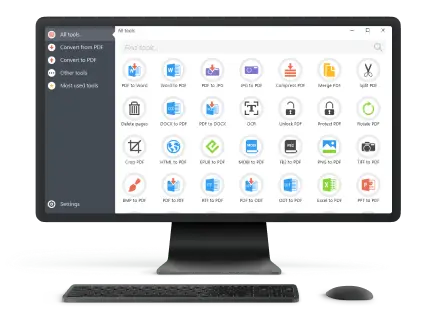Two Ways to Translate a PDF Easily
How to translate a PDF is a common concern for those handling multilingual documents—be it academic research, legal agreements, or product manuals.
Unlike regular text files, this format often makes it difficult to extract content from PDF accurately - writing may be embedded in images, scattered across multiple layers, or locked in non-copying formats. This can turn a simple task into a frustrating process.
In this article, we’ll walk you through the best tools and techniques to translate PDF files smoothly, ensuring you get precise results without losing essential information.
Method 1. Convert and translate PDF document
This involves changing the file into an editable extension—such as a DOC or plain text - before beginning the transfer. The approach is helpful when the PDF contains selectable words but grabbing it directly can lead to errors or formatting issues.
Converting first allows you to work with clean, accessible sentences, making the translation routine smoother and more precise. It also reduces the risk of missing material or introducing mistakes caused by fragmented sentences or unreadable characters.
Step 1. Use a PDF converter
PDF Candy Desktop simplifies the procedure of preparing files for translation by transforming them into a variety of searchable extensions. It efficiently handles multiple documents at once through its batch processing feature, which is especially useful for extensive translation tasks.
- Launch the PDF software on your computer.
- Choose "PDF to Word" or "PDF to TXT" from the main menu to locate the file you wish to transform.
- After adding the PDF, select the needed page range. Press "Convert" to begin the operation.
- Allow the application some time to complete the work. The DOC/TXT will be saved on PC.

Step 2. Apply the document translator
With your PDF now transformed, you can move on to translating a PDF into the preferred language.
Having the content readily accessible lets you take advantage of platforms such as DeepL, Google Translate, or Microsoft Translator. These ones offer more accurate and context-aware results.

After processing the text, it’s important to carefully examine the output text. Automated tools may occasionally produce awkward phrasing or miss subtle nuances, so a thorough review and adjustment help ensure the final version is clear, natural, and faithful to the original meaning.
Method 2. Online PDF document translator
Canva provides a flexible platform for handling PDFs by enabling to import documents and transform them into customizable designs. Its user-friendly drag-and-drop interface allows editing text in PDF, typography, and overall layout. This ensures the translated material integrates smoothly with the base visuals.
How to translate your PDF with AI using Canva
- Launch PDF translation tool and upload the file.
- Decide whether you want to process the entire document or select only specific pages in PDF.
- Choose the target language from the available options.
- If needed, edit the PDF directly within the preview - make corrections, adjust phrasing, or update any part of the narrative.
- Enable additional settings by ticking the relevant checkboxes:
- Mirror text direction for languages that read right to left.
- Shrink font size to ensure longer translations fit neatly into the layout.
- Duplicate pages automatically to preserve formatting.
- Start the transfer - Canva will instantly replace the text while maintaining the overall design and structure.
- Carefully review the result and employ any final modifications in the AI PDF editor.
- Once complete, export it in your preferred format.

The built-in translation relies on automated systems, which can struggle with context, idioms, or specialized terminology—especially in legal, medical, or technical data.
Tips on translating a PDF
1. Unlock non-selectable text
How to translate a scanned PDF? When dealing with or image-based material, Optical Character Recognition is crucial. It turns visual information into editable content, allowing accurate language conversion without manual retyping.
2. Maintain consistent character encoding
To avoid garbled symbols or missing glyphs, apply a uniform encoding standard - like UTF-8—throughout the translating a PDF. This is vital for languages using non-Latin alphabets.
3. Preserve the original layout
Keep the hierarchy intact, including headings, paragraphs, bullet points, and tables. Well-structured text aids comprehension and prevents loss of meaning that can occur with disorganized components.
4. Prepare for variations in length
Different languages may require more or fewer words to convey the same message. Make your design adaptable by resizing pictures, adjusting spacing, or modifying font dimensions.
5. Separate style elements
Do not embed formatting tags - such as bold, italics, or hyperlinks. Isolating these components reduces errors and ensures consistency after PDF translation.
6. Configure text direction
For languages written right to left, like Arabic or Hebrew, set the appropriate flow. Mixed-language substance demands careful alignment to avoid confusing or jumbled displays.
7. Embed fonts supporting target scripts
Verify the file includes fonts covering all characters in the translated language. This guarantees accurate display, even on devices missing those typefaces natively.
8. Divide textual content from interactive features
In graphics-heavy large PDFs, keep text away from functional elements such as images, charts, or buttons. This prevents unintended changes.
9. Update language metadata accordingly
After completing the operation, revise the PDF metadata to reflect the new language. This enhances accessibility, assists indexing, and improves compatibility with assistive technologies.
Conclusion
Translating a PDF can be a complex task due to the format’s unique structure and the challenges of preserving accuracy and layout.
However, by understanding the key steps you can achieve clear and reliable PDF translations. Whether you opt for PDF conversion methods, direct translation tools, or manual editing, paying close attention to technical details is essential for maintaining the document’s integrity.


